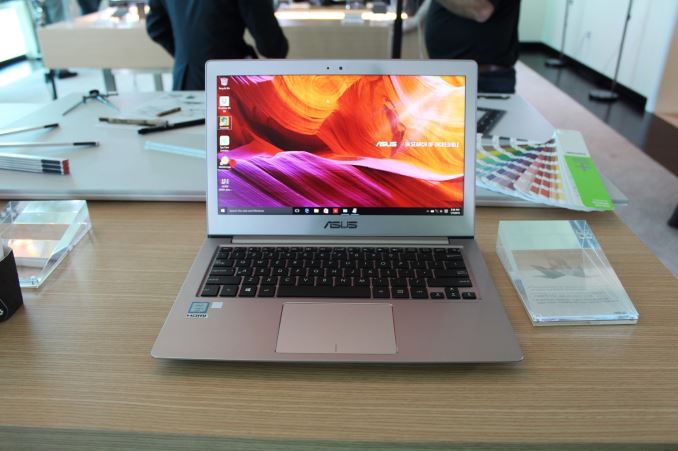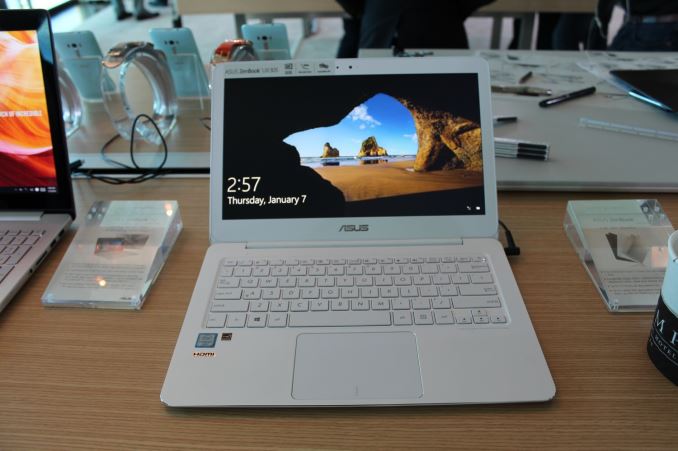ASUS Booth Tour at CES 2016: 10G Switches, External GPU Dock, USB-C Monitor and more
by Ian Cutress on January 19, 2016 9:00 AM ESTLaptops Laptops Laptops Laptops
Section by Brett Howse
ASUS didn’t have any really new laptops for CES, but we did get a chance to check out some that had been announced over the last couple of months with the launch of Skylake. The 15.6-inch ZenBook Pro is arguably ASUS’s flagship laptop, with a full aluminum chassis and 45-Watt Skylake CPUs. It also features an NVIDIA GTX 960M GPU, and PCIe storage. Optionally there is a UHD display with 100% Adobe RGB color space coverage. It’s a great looking laptop, and plenty powerful as well.
Moving down in price and performance is the UX303UA, which is a 13.3-inch Ultrabook with U series Skylake processors. It’s fairly light and thin, and is an incremental upgrade over the previous model. ASUS also had the UX305CA, which is the Skylake powered version of the UX305 that we reviewed in 2015, and ASUS sent us the new Skylake model to put through its paces so look for a review of this soon. The UX305 was one of our recommended Ultrabooks of 2015, as it offers more bang-for-buck at 8 GB of memory and 256 GB of SSD storage for just $699.
UX303UA
UX305CA
On the ROG side of things, I (Ian) saw the ROG GX700 laptop with the external water cooling graphics dock for the first time. Actually seeing the device (and how heavy it is), I finally understood the concept which didn’t come across that obvious before. The unit is a fully sealed graphics card and water loop, almost like a dock, which attaches firmly in place to the laptop and can’t be removed in use. When connected, it uses PCIe to interface between the CPU and GPU, much like other solutions such as the GS30.
What was perfectly clear is that this arrangement doesn’t come cheap. The laptop itself is a hefty number as well, making it less mobile than expected.














50 Comments
View All Comments
randomhkkid - Tuesday, January 19, 2016 - link
The ROG GX700 dock only contains radiators and pumps, the 980 laptop gpu is housed in the laptop itself. http://core0.staticworld.net/images/article/2015/1...hechacker1 - Tuesday, January 19, 2016 - link
That's a good start for a 10G switch, but it really needs more 10G ports to be useful. I deploy 10G all the time for my job, and we use the Intel X520, which is a generation behind, but stable as a rock and supported everywhere. It also can be found for relatively cheap (sometimes $250). At those prices it almost makes sense to build your own "switch" by just using 10G cards and directly connecting where you need it. I know in my environment I really only need 10G to my NAS, and then 10G to the workstation for media / VMs.BrokenCrayons - Tuesday, January 19, 2016 - link
A Cherry Trail phone with 4GB of RAM and 256GB of storage for $350 sounds great. Now if only a certain software company that makes operating systems would be kind enough to stop it with the silly pricing that keeps budget laptops with Cherry Trail processors chained to half that much RAM and 1/8th of the storage. >.<Pissedoffyouth - Tuesday, January 19, 2016 - link
Why the hell do they have to make a retarded version of the zenphone with bigger battery. Give me the atom version with 5000mah battery and I'll pay good money for itcfineman - Tuesday, January 19, 2016 - link
So when is that gsync monitor coming out? Seems like's it's been vaporware for a while... are they trying to work out the of the QC issues Acer has been dealing with or...???CaedenV - Wednesday, January 20, 2016 - link
@Ian, I am also excited that 10/t is finally coming to the consumer market! I have a NAS, and constantly have to move around ISOs and uncompressed video files/projects between my main PC and my NAS. Thankfully I get a solid 98-102MB/s... but the idea of being able to get 980MB-1GB/s sounds too good to be true! I mean, a Windows ISO would take a mere 10 secconds to transfer... heck at those speeds just use the NAS like a local HDD and write straight to and from it without ever transferring to a local disc!Thankfully for me though, the rest of my family is quite alright with gigabit Ethernet and WiFi, so having only 2 10Gb/s connections is not a bad limitation for me. They need to bring the price down a bit more before I'll bite though. $200 for an unmanaged switch with 2 10Gb/s ports and 4 1Gb/s ports, and $75-100 for each card. Still, I could see it being something when I do my next big build in a few short years.
... now if only they can do something about my 25mbps internet conneciton and 5mbps uplink...
sor - Wednesday, January 20, 2016 - link
The switches are underwhelming. We've had affordable switches with a few 10g + a bunch of 1g for awhile.10g baseT has been a pretty epic failure so far. I managed to find a 48 port Dell 3 years ago, pretty much the only full 10G baseT available, and it was so power hungry that it couldn't keep more than 24 ports running at once. They took it back, then discontinued the line. SFP+ and twinax for cheap copper interconnects worked much better.
merikafyeah - Wednesday, January 20, 2016 - link
10GbaseT is actually a mandatory part of the Thunderbolt 3 spec, so a TB3 (USB Type-C) switch could finally bring affordable 1GB+/s transfers to consumers.noeldillabough - Wednesday, January 20, 2016 - link
Will 10G work reliably over Cat6/6a? Or do we need to use Cat7/8 etc?sor - Thursday, January 21, 2016 - link
6a is the standard for 10g baseT. There are other types floating around like 6e, 7, 7a, etc, but none are standards based, mostly marketing.